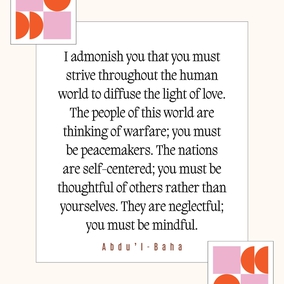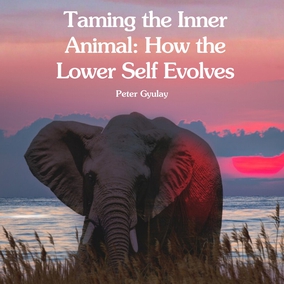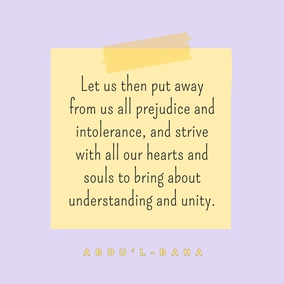The views expressed in our content reflect individual perspectives and do not represent the authoritative views of the Baha'i Faith.
How does our consciousness of the oneness of humanity affect healing and energy dynamics?
Baha’u’llah continually urges man to free himself from the superstitions and traditions of the past and become an investigator of reality, for it will then be seen that God has revealed his light many times in order to illumine mankind in the path of evolution, in various countries and through many different prophets, masters and sages. – Abdu’l-Baha, Divine Philosophy, pp. 8-9.
This quote from Abdu’l-Baha casts illumination from God as light revealed to help mankind progress along a path. That path has stages, each with its needs and requirements. Collective consciousness, capacity development, and service to the needs of humanity all distinguish this spiritual path:
A path invites participation, it beckons to new horizons, it demands effort and movement, it accommodates different paces and strides, it is structured and defined. A path can be experienced and known, not only by one or two but by scores upon scores; it belongs to the community. – The Universal House of Justice, 12 December 2011.
The idea that a path exists for the development of consciousness is an ancient idea. The Buddha taught about stages in the development of awareness (jhana in Sanskrit), recorded in the Long Discourses of the Buddha, in the story entitled “Fruits of the Homeless Life.” In the story, there is a king with a question he asks many people: “What are the fruits of a life of spiritual practice and meditation, which can be seen here in the material world?”
The king gets many answers, but finds his question is only properly addressed by the Buddha, who gives a detailed description of stages of consciousness, distinguished by particular sensations and perceptions. Each stage he describes as a more valuable fruit of spiritual practice. At the end of the story, the king is convinced to follow the Buddha and renounce the material world—which produces great joy:
…gladness arises in him, from gladness comes delight, from the delight in his mind his body is tranquilized, with a tranquil body he feels joy, and with joy his mind is concentrated. Being thus detached from sense-desires, detached from unwholesome states, he enters and remains in the first jhana, which is with thinking and pondering, born of detachment, filled with delight and joy. And with this delight and joy born of detachment, he so suffuses, drenches, fills and irradiates his body that there is no spot in his entire body that is untouched by this delight and joy born of detachment. – The Long Discourses of the Buddha, p. 102.
In the second jhana one attains consciousness of the passing away and arising of all things. This is, of course, one of the central teachings of the Buddha—everything is impermanent, and suffering comes from attachment to things.
We know that energy is released or absorbed when things change stages. Abdu’l-Baha describes the decomposition and composition (passing away and arising) in the flow of the spirit through the kingdoms of reality. Each kingdom of existence is called forth by the force of attraction, which manifests in powers and capacities that distinguish each from the other. The mineral kingdom manifests in cohesion; the vegetable, growth; the animal, sensation; the human, spiritual perception or in other words the powers of the rational soul. Abdu’l-Baha says that the higher kingdom is spiritual to the lower, the lower is relatively nonexistent, and that traversing the kingdoms requires decomposition of the lower for the higher:
Non-existence therefore is an expression applied to change of form, but this transformation can never be rightly considered annihilation, for the elements of composition are ever present and existent as we have seen in the journey of the atom through successive kingdoms, unimpaired; hence there is no death; life is everlasting. So to speak, when the atom entered into the composition of the tree, it died to the mineral kingdom, and when consumed by the animal, it died to the vegetable kingdom, and so on until its transference or transmutation into the kingdom of man; but throughout its traversing it was subject to transformation and not annihilation. – Abdu’l-Baha, The Promulgation of Universal Peace, p. 88.
The knowledge that Abdu’l-Baha describes in this talk seems to be a consciousness of energy, which cannot be destroyed and only changes form through stages of transformation.
To focus our awareness on this continuity means being freed from attachment to impermanent things, which arise and then pass away. The false idea that things no longer exist after changing form, Abdu’l-Baha refers to as annihilation—in particular the concept that the human soul or spirit ends at death. Perhaps this perspective comes from focusing too much on the objects of the external world, rather than the continuity and interconnection among all things. The Baha’i teachings define nature in terms of relationships, and religion as the connection that proceeds from this reality:
By nature is meant those inherent properties and necessary relationships derived from the realities of things. – Tablet to August Forel, p. 13.
Religion, then, consists in the necessary relationships deriving from the reality of things. – Abdu’l-Baha, Some Answered Questions, newly revised edition, p. 181.
The Baha’i teachings tell us in clear terms that we must learn to detach from the illusion of death, which causes much of our pain and suffering. Instead, we must learn to perceive the reality of our spirit, which is continuous and immortal:
The conception of annihilation is a factor in human degradation, a cause of human debasement and lowliness, a source of human fear and abjection. It has been conducive to the dispersion and weakening of human thought, whereas the realization of existence and continuity has upraised man to sublimity of ideals, established the foundations of human progress and stimulated the development of heavenly virtues; therefore, it behooves man to abandon thoughts of nonexistence and death, which are absolutely imaginary, and see himself ever-living, everlasting in the divine purpose of his creation. He must turn away from ideas which degrade the human soul, so that day by day and hour by hour he may advance upward and higher to spiritual perception of the continuity of the human reality. – Abdu’l-Baha, The Promulgation of Universal Peace, p. 90.
















Comments
Sign in or create an account
Continue with Googleor